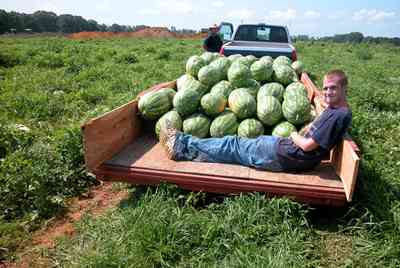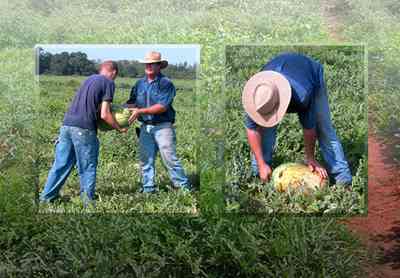-

Africa is considered to be the native home of the watermelon.
-

On the American continent, watermelons were grown as early as 1629 in Massachusetts, and prior to 1664 in Florida.
-

Watermelons grow best on a sandy loam soil.
-

Today there are more than 100 different varieties of watermelons. The flesh may be red, pink, orange or yellow.
-

The sweetest watermelons grow during long hot summers.
-

Ninety percent of watermelon is water.
-

Watermelon vines require considerable space. Seeds are planted one inch deep in hills spaced 6 feet apart. As the watermelon plants grows, the vines converge and the field becomes a sea of green vines.
-

The watermelon require a long growing season with relatively high temperatures. Daytime temperatures between 70 and 80 degrees F and nighttime temperatures between 65 and 70 degrees F are ideal.
-

Probably the most important indicator of ripeness is the underside which sets on the ground. Turn the melon over. It should be yellow or creamy colored on the underside. If it is white or pale green the melon is not ready to harvest.
-

Once picked, uncut watermelon can be stored for about 2 weeks at room temperature.
-

The flesh of the melon should be deep colored with mature seeds. Most watermelons have dark brown or black seeds.
-

Harvesting is particularly critical because watermelons do not continue to ripen after they have been removed from the vine. They should be picked at full maturity.
-

Watermelon is also high in Vitamin C and Vitamin A, in the form of disease fighting beta-carotene. Research also suggests that the red pigmented foods provide this protection.

 Africa is considered to be the native home of the watermelon.
Africa is considered to be the native home of the watermelon. On the American continent, watermelons were grown as early as 1629 in Massachusetts, and prior to 1664 in Florida.
On the American continent, watermelons were grown as early as 1629 in Massachusetts, and prior to 1664 in Florida. Watermelons grow best on a sandy loam soil.
Watermelons grow best on a sandy loam soil. Today there are more than 100 different varieties of watermelons. The flesh may be red, pink, orange or yellow.
Today there are more than 100 different varieties of watermelons. The flesh may be red, pink, orange or yellow. The sweetest watermelons grow during long hot summers.
The sweetest watermelons grow during long hot summers. Ninety percent of watermelon is water.
Ninety percent of watermelon is water. Watermelon vines require considerable space. Seeds are planted one inch deep in hills spaced 6 feet apart. As the watermelon plants grows, the vines converge and the field becomes a sea of green vines.
Watermelon vines require considerable space. Seeds are planted one inch deep in hills spaced 6 feet apart. As the watermelon plants grows, the vines converge and the field becomes a sea of green vines. The watermelon require a long growing season with relatively high temperatures. Daytime temperatures between 70 and 80 degrees F and nighttime temperatures between 65 and 70 degrees F are ideal.
The watermelon require a long growing season with relatively high temperatures. Daytime temperatures between 70 and 80 degrees F and nighttime temperatures between 65 and 70 degrees F are ideal. Probably the most important indicator of ripeness is the underside which sets on the ground. Turn the melon over. It should be yellow or creamy colored on the underside. If it is white or pale green the melon is not ready to harvest.
Probably the most important indicator of ripeness is the underside which sets on the ground. Turn the melon over. It should be yellow or creamy colored on the underside. If it is white or pale green the melon is not ready to harvest. Once picked, uncut watermelon can be stored for about 2 weeks at room temperature.
Once picked, uncut watermelon can be stored for about 2 weeks at room temperature. The flesh of the melon should be deep colored with mature seeds. Most watermelons have dark brown or black seeds.
The flesh of the melon should be deep colored with mature seeds. Most watermelons have dark brown or black seeds. Harvesting is particularly critical because watermelons do not continue to ripen after they have been removed from the vine. They should be picked at full maturity.
Harvesting is particularly critical because watermelons do not continue to ripen after they have been removed from the vine. They should be picked at full maturity. Watermelon is also high in Vitamin C and Vitamin A, in the form of disease fighting beta-carotene. Research also suggests that the red pigmented foods provide this protection.
Watermelon is also high in Vitamin C and Vitamin A, in the form of disease fighting beta-carotene. Research also suggests that the red pigmented foods provide this protection. One Tank of Gas
One Tank of Gas